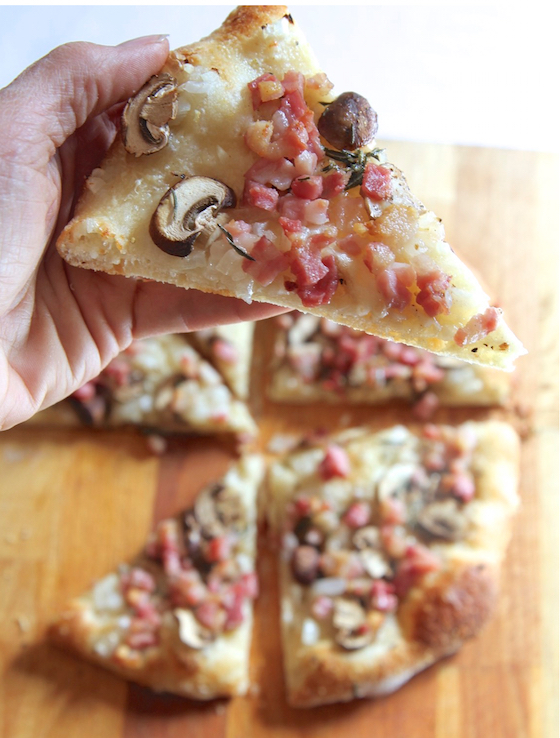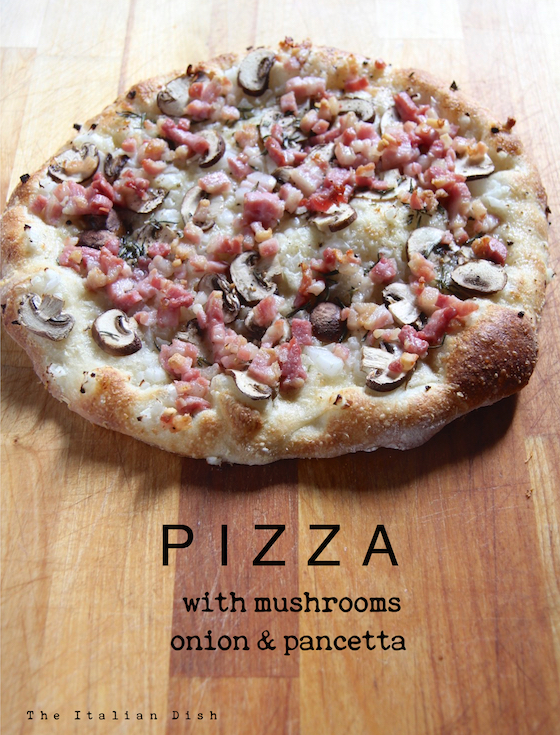
I just finished giving a Fall pizza making class and it seems like I get a lot of e-mails from readers who cannot attend the class because they don't live locally and want to know more about what we make in the class. So I'm going to talk a little bit today about what we discuss during class about the finer points of homemade pizza. We make six pizzas during class and this is one of them and one of my favorites. If you think bacon, onions and mushrooms go together just about perfectly, you will love this pizza. I'm also going to give you some parts of the handout that I give my students during class so you can see what we cover.
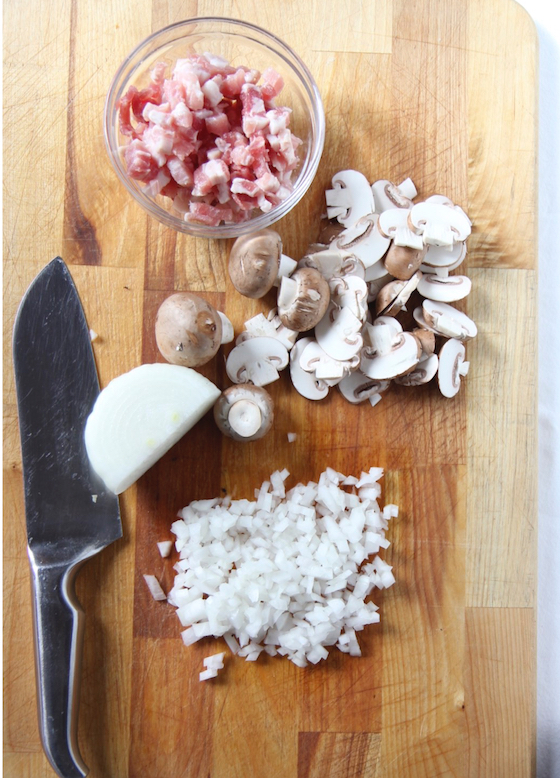
One of the first things I tell the students is that they will leave the class knowing how to make pizza dough without a recipe. In fact, making the dough without a recipe is better than using one. Why? Because recipes give you exact quantities of flour and water but you don't really know exactly how much flour and water is correct. There are some variables that you can't account for, like the exact measurement of flour, what kind of flour you are using, the humidity of the room, etc. It is far better to start out with a certain amount of water and then add flour until you get the right consistency of dough. Knowing when to stop adding the flour is the biggie here - too much flour makes a dry dough that will be tough. The key is to end up with a dough that is not so sticky that it comes off on your fingers but still feels moist. Remember how Play-Doh used to feel? That is what you want - Play-Doh feels moist in your hands but it doesn't come off on on your hands.
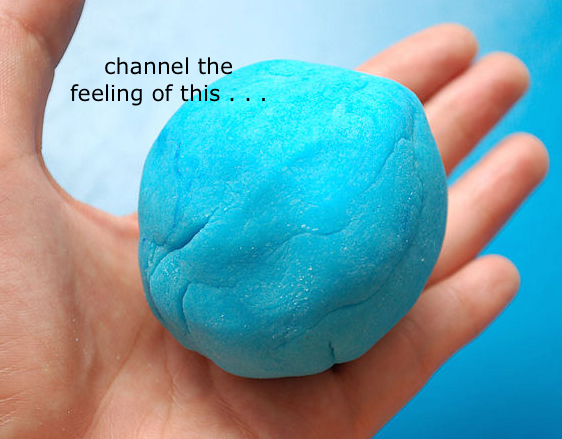
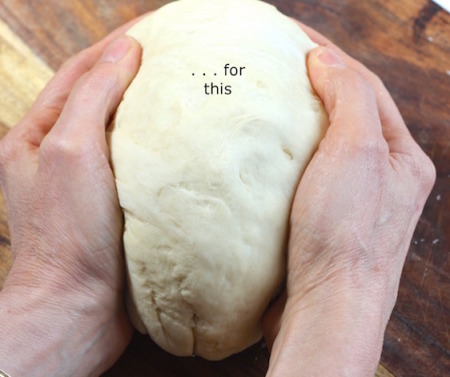
All you need to remember is how much water makes a nice personal size pizza, which is about ½ cup. So if you want to make pizza for two people, use one cup of water. After you see how big the pizzas are, you can adjust the quantities. For instance, I like a pizza size that is about ⅓ cup of water. That's just a better size for my pizza. You can figure this out later but using ½ cup per person is a good average starting point. A half cup water makes about 10 ounces of dough, which makes about a 10" round pizza.
Then all you do is add the other ingredients (yeast, salt, flour) to the water until you get the perfect consistency dough. That is it. It's simple as can be.
You can start mixing the dough in bowl with a spoon or fork and then when you get to the point where the dough is starting to come together, dump it out on a floured counter and finish it by adding small amounts of flour, kneading and then feeling the dough. Keep adding just a little flour at a time until the dough doesn't stick and come off on your hands anymore.
Place the dough in a larger bowl sprayed with nonstick cooking spray, sprinkle the top with flour and cover with plastic wrap so it doesn't dry out. Let it rise at room temperature for a good hour or two. At this point, you can make pizza with it but I highly recommend making the dough the day before and placing it in the fridge to sit all night. The next day, the dough will be more flavorful and easier to handle. It is so worth it.
The next day, take the dough out of the fridge about an hour and a half before you want to make pizza. Divide the dough into individual dough balls and set them on a well floured sheet pan. Sprinkle the tops with flour, cover loosely with plastic wrap and let rise. They will be full of air at this point and make a nice crust.
More Tips:
✓ You can also freeze dough easily. Remember - heat kills yeast, cold does not kill yeast.
✓ Long, cold fermentations produce gluten just like kneading by hand would. Less yeast and longer cold fermentations also produce tastier doughs than more yeast and a fast fermentation.
✓ Pizza Stone: Essential for home ovens for making pizza. You will find these cheaply just about anywhere now. Do not wash it ever. It will absorb soap and water. Just scrape off residue.
✓ Using parchment paper is the easiest way to slide your pizza onto your pizza stone.
✓ Whether to put the stone on the upper rack or lower rack is a personal preference.
✓ If you have a convection oven, use the convection setting when you bake pizza. Bake at the highest temp your oven will go.
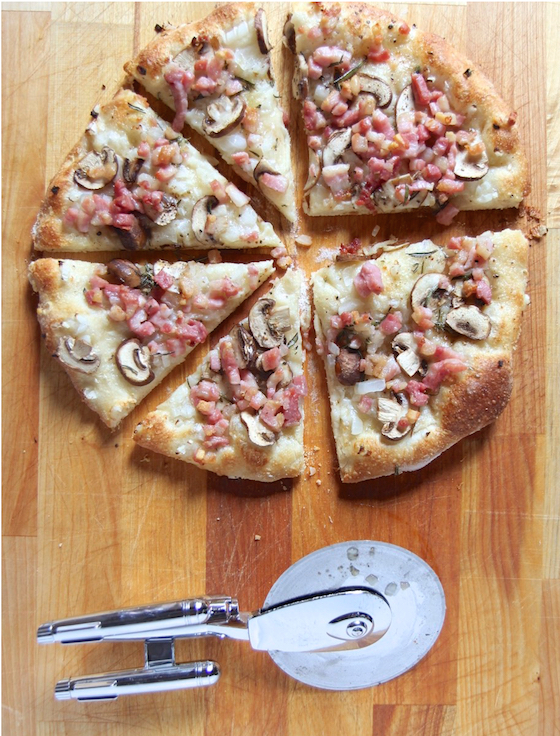
Homemade Pizza with Mushroom, Onion and Pancetta
for a printable recipe click here
makes two 10-inch pizzas (about 20 ounces of dough)
Try to make the dough the day before you need it (you can even make it a couple of days ahead of time). It will be easier to handle and taste better - the flavor develops as it undergoes a slow, cold fermentation in the fridge.
I use instant yeast because it requires no proofing and is more reliable.
A piece of baking parchment helps tremendously in transferring your pizza to the oven.
* Different flours produce different results. You can just use plain all-purpose flour and that makes a fine pizza. You can use all bread flour, which will make a sturdier, crisper crust. Italian 00 flour is another fine choice and make a crispy crust. You can even mix flours.
- 1 cup water
- ½ teaspoon instant yeast
- ½ teaspoon sea salt or kosher salt
- enough flour* to form a dough that is still slightly sticky (about 3 to 3½ cups). The dough should feel a little wet, like Play-Doh, but should not come off on your fingers when you press it.
- 1 Tablespoon extra virgin olive oil
- ⅓ cup freshly grated hard cheese (pecorino, parmigianno, etc.)
- ¾ cup sliced fresh mushrooms
- ⅓ cup finely chopped onion
- a little chopped fresh rosemary (optional)
- 4 ounces chopped pancetta
- freshly ground black pepper
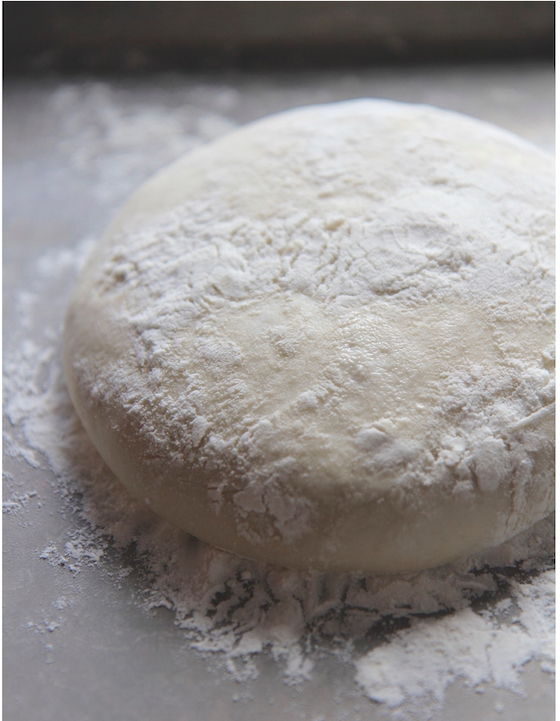
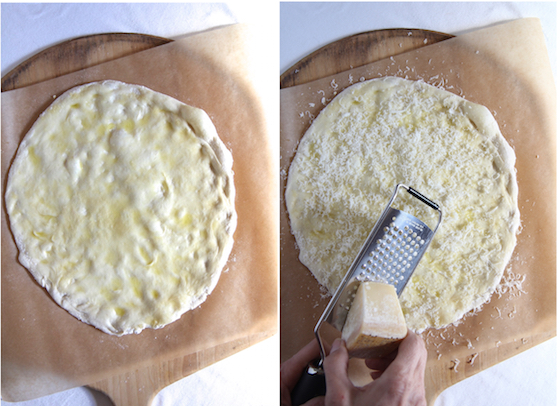
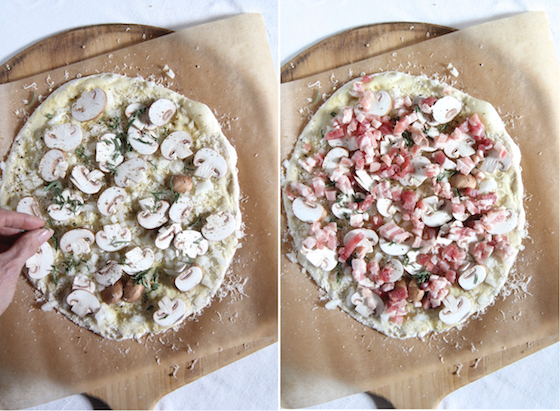
Whisk water, yeast and salt in a small bowl until blended. Add about one cup of the flour and blend with the fork. Keep adding some flour until the dough comes together into a ball. The dough should still be a little sticky. Dump out on the counter and finish the dough by kneading and adding small amounts of flour until you get a dough that is not sticky but not dry (Play-Doh!) It should not come off on your hands. If it does, keep adding a little flour and incorporate by kneading until your dough is the right consistency. Place in a greased bowl (using a little oil or Pam), flour the top of the dough and cover with plastic wrap. Let rise for an hour (or two, if the room is cold). Place bowl in fridge overnight.
The next day, it’s nice to form the dough into equal size balls if you have the time (10 oz. makes a nice personal size pizza that’s about 10 inches). I form them into balls and let them rise for about an hour or hour and a half, before I plan on making the pizzas. You can lay them out on a floured sheet pan and then cover lightly with plastic wrap. Be sure to flour the sheet pan and the tops of the dough balls, because as the dough sits it will become a little wetter and the plastic will really stick to it.
If you don’t have time to form the dough into balls and let them rise again, you can use the dough straight from the fridge, but keep in mind that it will be a little harder to roll out and it will also not have developed the air inside the dough to produce a crust with lots of air pockets.
Preheat your oven to 500° F, with a pizza stone in the bottom third of the oven.
Place a piece of baking parchment on top of a pizza peel or on top of an overturned sheet pan. Roll or stretch your pizza dough to a 10" round and place on the baking parchment. Brush the dough with the olive oil, sprinkle the cheese over the top and place the mushrooms, onion, rosemary and pancetta on the top. Grind black pepper over the top.
Transfer the pizza to your pizza stone in the oven by sliding it from the pizza peel to the stone, keeping the pizza on the baking parchment. Cook for abou two minutes and then pull the parchment out from under the pizza - it should just slide out at this point. Cook the pizza further, for about 7 - 8 more minutes, or until the top is cooked as you like it.
